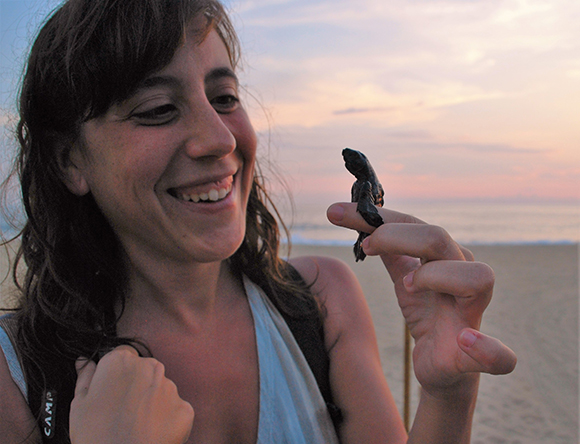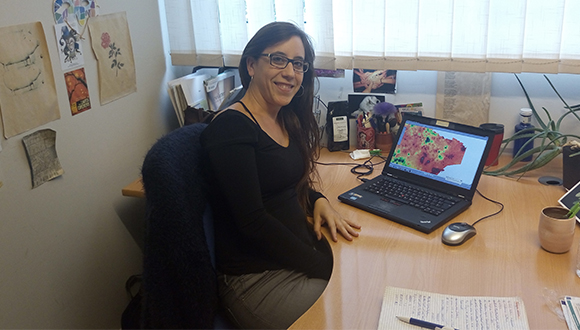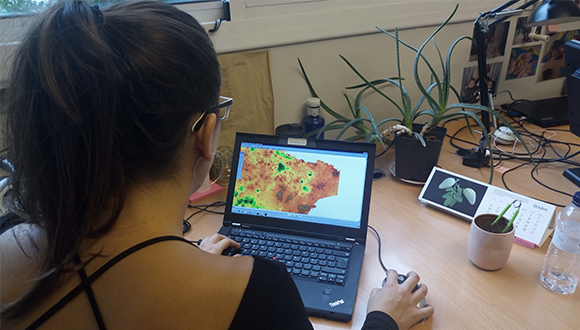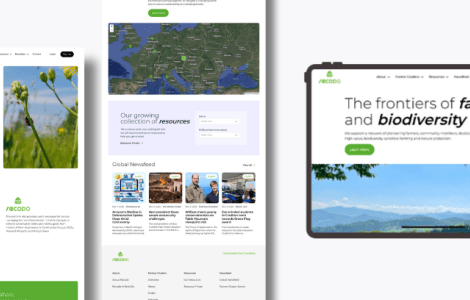“Observing the Earth is like taking a patient’s pulse”
Ivette Serral has a degree in Environmental Sciences from the UAB and has been working as a technician in remote sensing and GIS at CREAF since 2002. She is currently a member of the GRUMETS research group and participates in the ConnectinGEO and Ecopotential projects. The diversity of her day to day work is stimulating, though it also makes it hard to put her mind to analysis of data and results.

What are Earth observation and geographic information systems?
Earth observation (EO) is the unprocessed data obtained by satellites or sensors on the ground. Geographic information systems (GIS) and remote sensing are methods and tools which permit the management and manipulation of those data and the acquisition of reliable results.
What would you say to people in order to get them interested in working in the field?
This branch of science has a mysterious and hidden side to it. You can see things about the Earth that are not immediately clear or are not normally visible. There is a lot more information in a satellite image than seen at first glance, and this is the information that you want to extract. The way that you go about revealing the hidden truth of the image is the part which for me is somewhat magical and mysterious. I also like this work because it deals with our surroundings, vegetation, geology… This is interesting work for those of us who enjoy contact with the natural world.
"The Earth is able to speak to us through the signals that we pick up in our field of work"
Is it a male-dominated branch of science?
It may seem that way, but for example in our group were are just as many men as women. Perhaps on the information technology side of things you may find more men, but when it has to do with applying the information to the forestry sector or to biodiversity there are just as many men as women, or even more women.
But isn’t it the case that the most respected researchers are typically men? Why do you think this is?
Yes, I think that in society there is currently still not real equality in terms of reconciling family and professional life, and in many cases it is often the women which sacrifice their professional lives in order to take care of the family. The opposite is not very common.
Do you think that you have had more difficulties in your career as a result of being a woman?
Personally, I haven’t felt any sort of workplace or career discrimination as a result of being a woman and I think that I have always been treated and valued justly and objectively, both by my superiors and my peers. I feel fortunate about that.

What led you to work at CREAF?
I did my undergraduate internship at CREAF with Josep Maria Espelta. Because my favorite subjects during that time were GIS and remote sensing, I was able to begin working here after I graduated because they were looking for someone who knew how to correct aerial photos for a study of land use change. Later, I worked on other projects with Arnald Marcer, Xavier Pons, and now with Joan Masó.
How would you define your work at CREAF?
I am a GIS and remote sensing technician, my work is different every day. For one, I work on writing documents for the European Projects, and I also have to carry out what we said we would do on those documents, which is obtain results. I also work on searching for new projects, and I am the tester for Miramon, a software package which allows the visualization, editing, and analysis of maps, photos, and digital terrain models. I test the new versions that are released.
"This branch of science has a mysterious and hidden side to it. You can see things about the Earth that are not immediately clear or are not normally visible"
What do you like most about your work?
What I like most is that it is quite varied, I do many different things, but at the same time this is also the worst thing about my job! Doing so many different tasks doesn’t allow me to concentrate on anything in particular. We are always putting out fires here and there. I would like to be able to spend a lot more time working on data analysis.
Why are GIS and remote sensing important for society?
Observing the Earth is necessary for human beings, it’s like taking a patient’s pulse. The Earth is able to speak to us through the signals that we pick up in our field of work. EO allows you a realistic and above all continuous view of the state of the Earth, and this should also serve politicians so that they are able to make the right decisions.

How has the field advanced since you began working in it?
The most important change has been the arrival of platforms such as Google Maps and others. This has been a positive development because it has made geographic information arrive to the fingertips of many people, but at the same time it has trivialized the technology. Someone may question why we need to spend money on complex information systems such as Miramon if we already have Google Maps.
"In society there is currently still not real equality in terms of reconciling family and professional life"
Is there a solution to this problem?
Media outlets should make greater use of the information we provide because it is actually accessible to them. For example, the meteorologists from TV3 [Catalonian network] have helped along these lines. They often show satellite images; when a forest fire has occurred, they explain a bit about the satellite and its features.
To finish, what are the lives of people who work in research like?
I think that generally speaking, we always have to be finding new funding, working on many projects at once, and it often happens that we aren’t able to deal with such a large load. If we were able to work on only one project and dedicate our full attention only to that we would have more time for everything and it would be more enjoyable. I believe that you should be able to dedicate your full time and attention to whatever particular task you may have at hand. I think that science is functioning this way everywhere, and it’s a general sensation in Europe from what I have leaned in discussions with other centers. There is a lack of base funding, money invested in specific projects, and research carried out for the sake of research.






